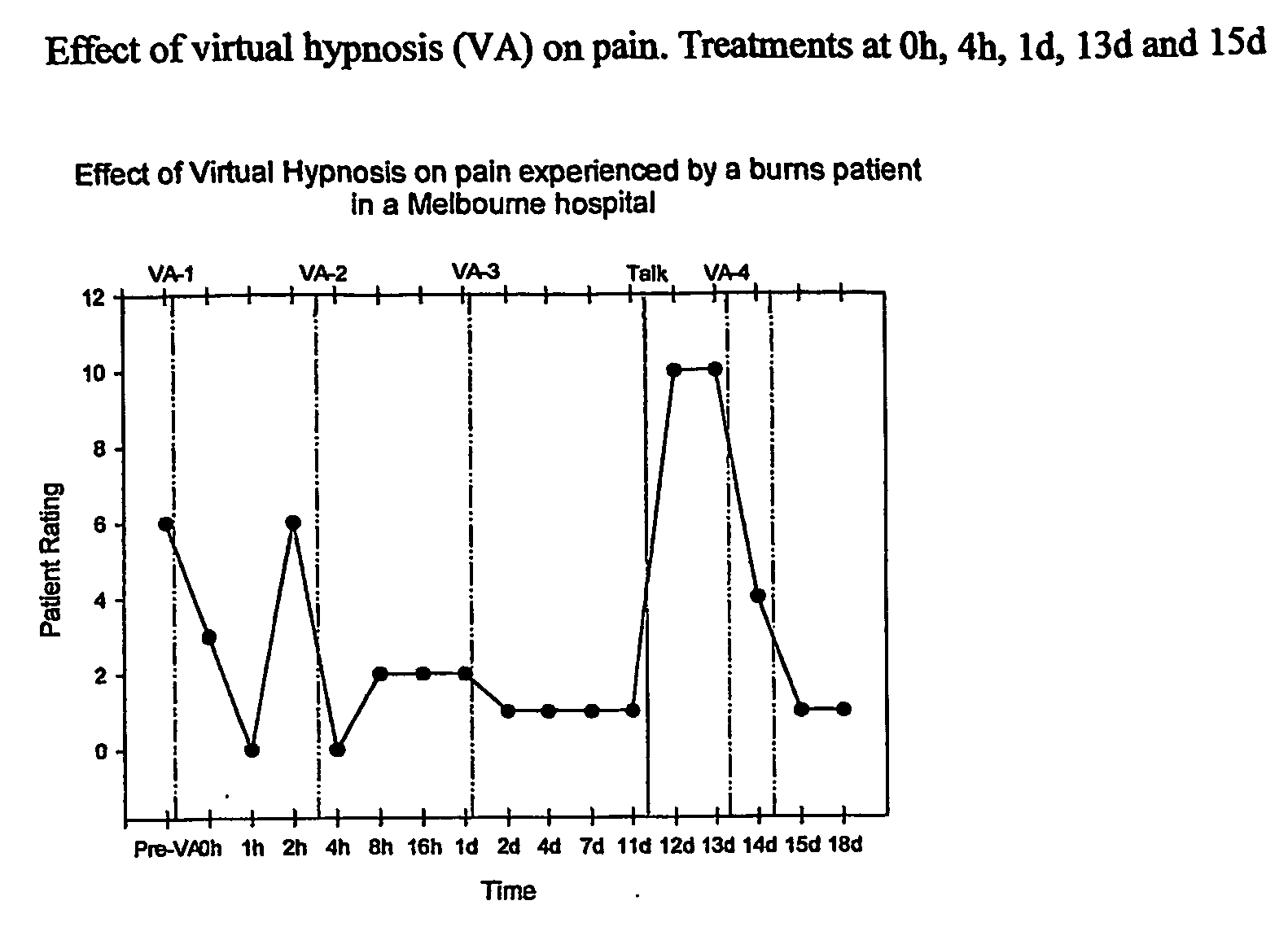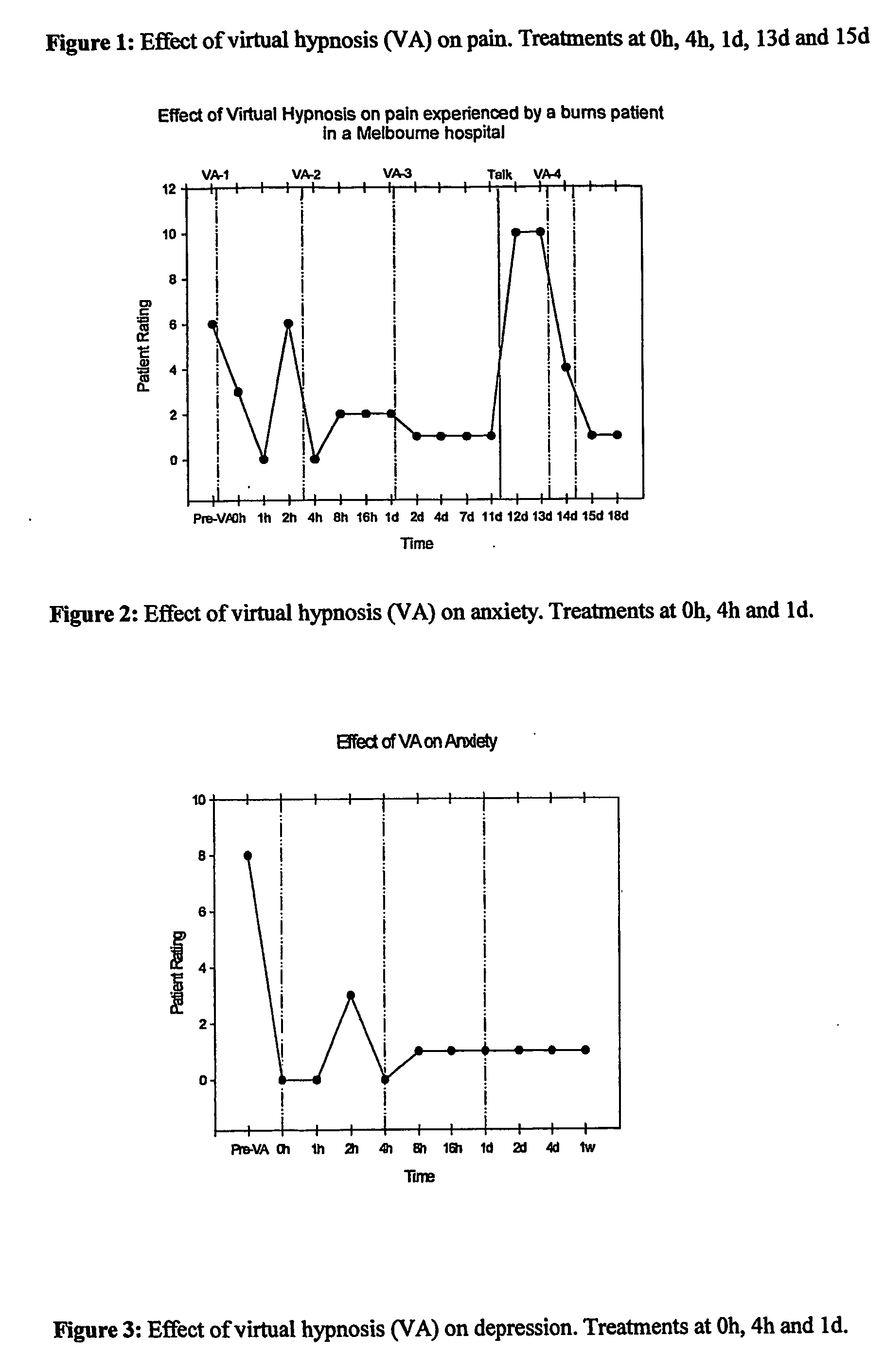Altered states of consciousness in virtual reality environments
- Summary
- Abstract
- Description
- Claims
- Application Information
AI Technical Summary
Benefits of technology
Problems solved by technology
Method used
Image
Examples
case study 1
ent in Cancer
Introduction and Patient Background
[0044] The patient was a 36year-old female with cancer who developed Hodgkins Lymphoma at 19 years of age with subsequent lung metastases. Problems associated with her condition are highlighted in the following bullet points. [0045] The malignancy was aggressively treated with cardiotoxic, chemotherapy drugs. The chemotherapy drugs caused cardiac insufficiency and, eventually, she needed a heart transplant. [0046] The patient had a tracheotomy tube inserted because muscles in her neck and chest were so weak that she had extreme difficulty removing phlegm and saliva from her lungs by coughing. Sputum and saliva were removed via the tracheotomy tube. The tracheotomy tube interfered with oral feeding, so a stomach tube was inserted to supply food. [0047] The patient developed facial palsy, and lost control of muscles on the left side of her face. She was unable to open her left eye, and vision in her right eye was blurred. Blurred visio...
case study 2
rder in a Burns Patient
Introduction and Patient Background
[0059] On the 12th of Oct. 2002, Muslim extremists exploded an incendiary device that destroyed the Sari club in Bali Indonesia. The Sari club was a popular destination for travelers, and the terrorists carefully planned the explosion to kill American, Australian and English tourists.
[0060] The patient described in this study was a 28-year-old Australian, visiting Bali with his local football team. He went to the Sari Club on his first night in Bali, and was standing about 10 meters away from the bomb when it exploded. The force of the blast hurled him several meters across the room amid a fireball that burned 60% of his total body surface area and ruptured tympanic membranes in both ears. After a short period in the Bali hospital, he was transferred to an Intensive Care Unit at a Melbourne Hospital. The patient was discharged from the hospital 43 days after the Bali bomb blast.
Materials and Methods
[0061] Virtual Hypnos...
case study 3
n in Surgical Environments
Introduction and Patient Background
[0076] The patient was a 34year-old female in labor at the Francis Perry Hospital (Melbourne). Labor was induced with oxytocin, and the patient was anticipating normal vaginal delivery. After 10 hours of labor, the obstetrician decided that vaginal delivery was associated with unacceptable risks, and she recommended surgical intervention by Caesarian section. The obstetrician's comments were unexpected, and imminent surgery manifested in anxiety and emotional trauma for the patient and her family.
Materials and Methods
[0077] Virtual Hypnosis was provided to the patient using a portable brief case unit specifically designed by Virtual Medicine. The Virtual Hypnosis device consisted of a head mounted display and a micro-DVD player supplied by Mindflux, and a DVD called Virtual Analgesia (Rivers). The patient experienced relaxing country scenes, a hypnotic spiral, various non-verbal sounds, and verbal directions for relax...
PUM
 Login to View More
Login to View More Abstract
Description
Claims
Application Information
 Login to View More
Login to View More - R&D
- Intellectual Property
- Life Sciences
- Materials
- Tech Scout
- Unparalleled Data Quality
- Higher Quality Content
- 60% Fewer Hallucinations
Browse by: Latest US Patents, China's latest patents, Technical Efficacy Thesaurus, Application Domain, Technology Topic, Popular Technical Reports.
© 2025 PatSnap. All rights reserved.Legal|Privacy policy|Modern Slavery Act Transparency Statement|Sitemap|About US| Contact US: help@patsnap.com



